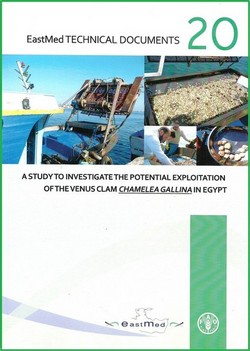
Eastmed Technical Documents 20
A Study to Investigate the Potential Exploitation
Of the Venus Clam Chamelea Gallina in Egypt
Preface
The Project “Scientific and Institutional Cooperation to Support Responsible Fisheries in the Eastern Mediterranean - EastMed is executed by the Food and Agriculture Organization of the United Nations (FAO) and funded by Greece, Italy and EC.
The Eastern Mediterranean countries have for long lacked a cooperation framework as created for other areas of the Mediterranean namely the FAO sub-regional projects AdriaMed, MedSudMed, CopeMed II and ArtFiMed. This made it more difficult for some countries in the region to participate fully in international and regional initiatives for cooperation on fishery research and management following the very encouraging experience of technical and institutional assistance provided to countries by the other FAO sub-regional Projects.
EastMed
Was born to support the development of regional cooperation and the further development of multidisciplinary expertise necessary to formulate appropriate management measures under the FAO Code of Conduct for Responsible Fisheries and the principles of the Ecosystem Approach to Fisheries (EAF) to ensure rational, responsible and participative fisheries management.
The project’s longer-term objective is to contribute to the sustainable management of marine fisheries in the Eastern Mediterranean, and thereby to contribute to supporting national economies and protecting the livelihoods of those involved in the fisheries sector.
The project’s immediate objective is to support and improve the capacity of national fishery departments in the sub-region to increase their scientific and technical information base for fisheries management and to develop coordinated and participative fisheries management plans in the Eastern Mediterranean sub-region.
Abstract
In Egypt due to the Nile delta and the presence of large shallow (0-20 m), with areas composed of sand and mud, there could be a great potential for the exploitation of a variety of clams. Given the big gap in knowledge on clams in Egypt the FAO EastMed project has started a study to support Egypt in exploring the possibility to determine if the clam resources exists, and then assist Egypt in developing a potential fishery. The study was conducted between Rasheed and Burullus, where there is a large extend of 60 km of shallow water sandy bottoms. The depth was decided to be limited to 10 m depth contour and target the main potential stock present, that of the clam Chamelea gallina. In total 126 hauls were conducted covering a coastline of about 60 km from 3- 10 m in depth. All the species sampled were counted and weighed and Chamelea gallina samples were also kept for further processing in the laboratory, where the collection of stock parameters, microbiological and heavy metal analysis were conducted Overall the results show that the commercial clam Chamelea gallina has a potential for exploitation together with other potentially commercial species such as the changeable nassa Nassarius mutabilis and the bivalve Anadara polii. Most of the biomass is located on the Western side of the area investigated and close to the fishing port of Rasheed, making the area more easily reachable. The results obtained from the bacterial and heavy metal analysis show that the clams are in general within safe limits especially in the western and middle parts of the investigated area and when compared to other commercially exploited bivalve species in Egypt such as Tapes decussates. In the investigated area when considering the MSY and the cost structure of small trawlers the recommendation is that as a start 10 hydraulic dredgers would be suitable to exploit the fisheries resources. Most of the potential production would probably be for local consumption in Egypt, since export is rather difficult due to the special regulations for the import of bivalve species. The main constraint for the commercialisation of the products will be the market, since these species are at present not commercialised in Egypt, market strategy should be devised in order to successfully introduce the product in the local markets. Once the market has been understood and the products are successfully introduced an EAF management plan could be drawn up.
Table of Contents
1. Introduction
2. Materials and Methods
Sampling design .
Sampling Area .
<!--Sample processing
<!--Data analysis
3. Results
<!--Catch data
<!--Biological characteristics of C. gallina
<!--Assessment of the resources
<!--Microbiological Analysis
<!--Heavy Metal analysis
4. Discussion
<!--Information on the resources
<!--[if !supportLists]--> · Exploitation and Commercialisation of the product
<!--Microbial and Heavy metal contamination in C. gallina
5. Conclusions and Recommendations



ساحة النقاش